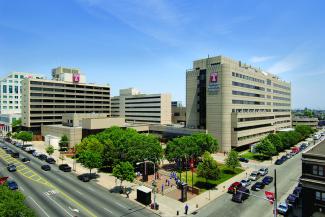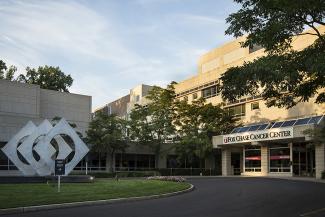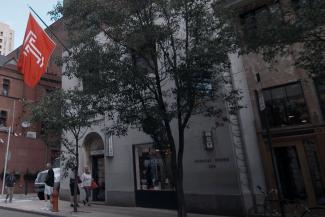Temple Health's urologists offer minimally invasive and robotic treatments for kidney cancer, including robotic-assisted partial and total (radical) nephrectomy.
Robotic-Assisted Partial Nephrectomy
At Temple, the majority of kidney tumors, masses or complex cysts can be treated with a procedure called partial nephrectomy. This is the surgical removal of the cancerous section of the kidney. In this procedure, a very minimal portion of the normal kidney is removed with the tumor. The vast majority of the healthy kidney tissue is spared and surgically repaired so blood and urine can flow normally. This is sometimes called "nephron-sparing" or "kidney-sparing” surgery.
Robotic-assisted partial nephrectomy allows the removal and reconstruction of the kidney to be performed through multiple keyhole-sized incisions, as opposed to a single open incision measuring several inches across the side of the abdomen. The large incision with open surgery typically is painful and may require partial removal of a rib. Although laparoscopic partial nephrectomy can also be performed using smaller incisions, it can be technically challenging, so these procedures are more often converted to a total nephrectomy.
During the robotic procedure, a Temple urologist may temporarily halt blood flow to the affected kidney before cutting away the cancerous area. The magnified view of the kidney and the ideal positioning of the surgical instruments allow the surgeon to work with great precision and control when removing the kidney tumor, preventing bleeding, and then repairing the delicate vessels and tissues of the functioning kidney to be left behind.
The tumor is removed from the body (after being placed in a small plastic bag) through one of the keyhole incisions. In some cases, nearby lymph nodes will also be removed and examined (lymph node dissection) as part of the nephrectomy or partial nephrectomy.
A reconstructed kidney offers two main advantages: It may decrease the risk of long-term kidney failure and acts as a reserve if the other kidney is damaged. Keeping as much healthy kidney tissue as possible may help you avoid the need for dialysis in coming years, especially if you have pre-existing high blood pressure and diabetes.
Many studies show that cancer survival rates in patients having partial nephrectomy are equivalent to those seen in patients having radical nephrectomy; however, the patients having the kidney-sparing procedure also benefit from many other long-term health advantages and improved overall survival.
Robotic-Assisted Total Nephrectomy
In cases where the kidney tumor is too large or problematic to spare the kidney, or in cases when the kidney no longer functions (sometimes due to noncancerous reasons), Temple's urologists may recommend the complete surgical removal of the kidney. However, the removal of only part of the kidney is always preferred, and Temple urologists may be able to perform a partial nephrectomy even in patients with complex tumors who have been told by others that they require a total (or "radical") nephrectomy.
The entire robotic-assisted procedure is performed through tiny keyhole-sized incisions, as opposed to a large open incision on the side of the abdomen, an incision that is often painful and requires partial removal of a rib.
The abdomen is first inflated with air (carbon dioxide) to provide the surgeon with enough space to move the colon away from the kidney. The surgeon identifies and clips off the blood vessels leading into the kidney so that blood flow is permanently halted. The kidney is then surgically removed from the bowels, liver, spleen, pancreas and/or back muscles. In most cases, the adrenal gland is spared. Once free, the kidney is specially bagged inside the body and then removed by enlarging one of the keyhole incisions.
The Advantages of Robotic Surgery for Kidney Cancer
As with most robotic-assisted procedures, there is typically much less pain than with the open procedure, less blood loss (and therefore less need for a blood transfusion), less scarring (both internally and externally), a shorter hospital stay (usually one to two days versus up to a week), and shorter overall recovery time before a return to normal activities.
Using the robot, we can complete lymph node dissections that may match or surpass what most experienced open surgeons are able to offer. If your urologist tells you that you are not a candidate for a minimally invasive approach or a kidney-sparing approach, a consultation with a Temple robotic surgeon is highly recommended.
Ready for an Appointment?
Find a doctor near you, request an appointment, or call 800-TEMPLE-MED (800-836-7536) today.


